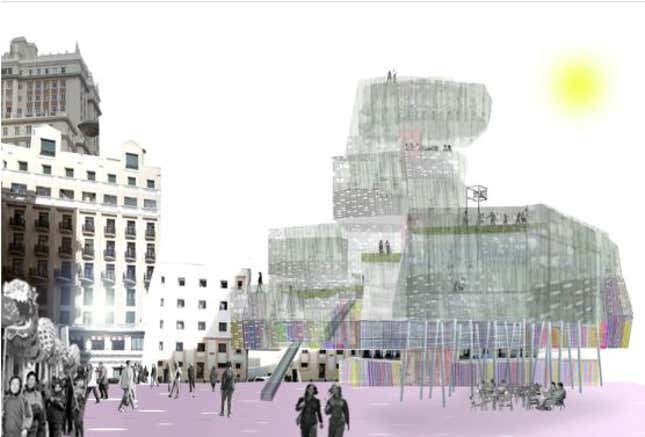
Could modern Spain’s era of monumental urban projects finally be over? After a decades-long spurt of massive, influential development plans, Spain’s cities are now littered with half-built grand schemes that never happened. Madrid is currently missing a planned convention center (still a hole in the ground), a grandiosely titled arts center called the Coliseum of the Three Cultures (still two empty lots), a new stadium to replace one razed in 2006 and the long-promised, almost traffic-free Paseo Del Arte, a parkland promenade linking the city’s main museums.
Spain’s third city, Valencia, is faring no better. Here a new residential neighborhood’s construction has stalled, an extension of the metro system is on hold and no work has occurred on its half-built new stadium since 2009. These plans were hatched in the wake of a long list of successful cultural and urban regeneration schemes in recent decades, but with Spain’s property bubble long-since popped and cash for development blown away by austerity, their development is no longer viable. For a country whose bold urban schemes were once aped across the world, this is an abrupt and painful turnaround.
The change is striking partly because so many similar projects across the world are still being influenced by Spain’s past successes, especially in Europe. Find a harbor city trying to revive its docks with a waterfront esplanade, and Barcelona’sOld Port is almost invariably one of its name-checked role models. Likewise, following the success of Frank Gehry’s Guggenheim Bilbao, numerous cities have jockeyed to create their own Guggenheim effect, in the not unfounded belief that an eye-catching, cultural edifice can flush a rundown city’s grimy streets clean with streams of tourists. But as others rushed to emulate it, Spain’s powers-that-be became somewhat drunk on their own success. The country’s planners approved yet more spectacular projects that, while they wowed the public in the planning stage, ended up becoming loathed monuments to pork barrel sleaze and political vainglory.
Chief among these is Santiago Calatrava and Felix Candela’s City of Arts and Sciences in Valencia, completed in 2005 to widespread praise. With buildings resembling dinosaur skeletons, fish heads, armadillos and stormtroopers’ helmets, this grand assembly comprising a museum, an opera house, a cinema and an aquarium certainly looks remarkable. Costing€1.1 billion, it nonetheless failed to provide a massive compensatory visitor influx for its price, even while beaches nearby heave with pasty North European bodies. Its cost is still taking a toll on city funds today, and with the Valencia region now requesting a government bailout of €5 billion, its construction is bitterly regretted by some. Leaked evidence suggesting that Calatrava was paid€94 million for the project has since turned the architect into a controversial figure, pilloried by a Spanish language website entitled, “Calatrava Bleeds You Dry.”
Meanwhile, in Galicia, Santiago de Compostela’s City of Culture, which opened last year, has also signaled an end to the era of look-at-me public projects. Yet another cultural complex, this one by U.S. architect Peter Eisenman, it’s also stunning, a great curve of windswept stone that looks as if it’s been unearthed from beneath its hillside by a massive storm. But coming in four times over budget and still far from complete, its profligacy has infuriated residents in a depressed region, who see it as a vanity project for local politicians’ legacy building. While it does make some sense for a country so popular with tourists to stimulate growth by building must-see cultural flagships (and most money came from outside the region) Spain’s latest effort doesn’t seem to have become anyone’s must-see just yet. As belief that these complexes can boost the economy falters, Spain is unlikely to build anything of this scale and cultural ambition anytime soon.
While plans for Madrid’s new culture palaces and Valencia’s metro extension gather dust, the country’s yen for grand projects is still far from dead. Turning away from cities and the arts, the Catalonia region has recently announced €6 billion of privately sourced funding for a coastal leisure complex. Meanwhile, the company Las Vegas Sands has chosen Spain as the site for a 12 hotel, six casino-strong gambling leviathan dubbed “Eurovegas” (as The Atlantic reported last month) settling this month on Madrid’s outskirts for its location. While any jobs will be welcome in recession-hit Spain – even the mainly low-paid, low-skilled ones Eurovegas will provide – this sounds like a return to the bad old days of the 1970s and 80s. Back then, Spain’s coasts were known across Europe for trashy, gimcrack resort architecture, while the country lured visitors on the strength of price and guaranteed sunshine alone. Spain’s ambitious projects of the past two decades helped replace this tawdry image with one of cultured, forward-looking aspiration. The boom years that bankrolled these projects now gone, it seems that ambition is now something Spain feels it can’t afford.
Also on our sister site Atlantic Cities:
The Lifecycle of a ‘cool’ neighborhood